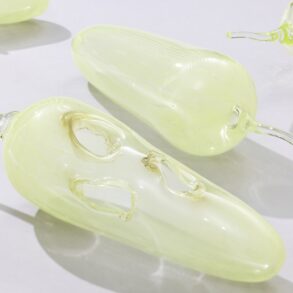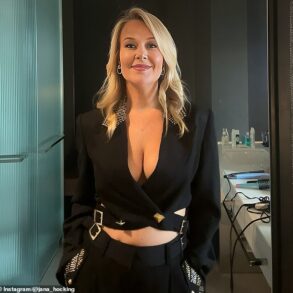Artist Angelica Neyra maneuvers beyond beauty to reveal the grotesque connection between the meat industry and the exploitation and objectification of women in society through an intriguingly visceral exhibit.
“Carniceria” (butcher shop) is Neyra’s first solo exhibition at the 621 Gallery in Railroad Square, and its runs through March 29.

Manipulating beauty
The United States has a history of building industry on living beings. Animal exploitation continues as one of the largest industries with powerful influences over economics and legislative policies in the United States. According to the North American Meat Institute, the meat and poultry industry accounts for 5.6% of the gross domestic product, whose market is expected to grow by 4.39% annually.
Animal Equality reports that there are approximately 250,000 farm factories in the US, many of which treat the animals poorly and house them in unimaginable conditions. The oppression faced by these animals due to the greedy acts of a powerful industry mirrors that of the oppression felt by women as “pieces of meat” in a system built on patriarchal ideals and an essence of machismo.
As women struggle to regain rights to their bodies and maintain bodily autonomy, their non-human counterparts suffer the realities of such fears. Milk cows are artificially inseminated at young ages over and over again, only to be slaughtered by the age of 5, only a third of their life lived.
The world delivers horrors, but the beauty of life is that within it all, an intelligent, informed, creative woman like Angelica Neyra can witness this in real-time and choose to make wicked, visceral art in response.

‘Ties between meat and masculinity’
In “Carniceria” Neyra uses sculpture to highlight the exploitation and expectations placed on women’s bodies and the abuse experienced by primarily female cows subject to growth hormones, fed plastic, and whose instincts are controlled, making their quality of life horrific.
“This series of work explores the ties between meat and masculinity, taking inspiration from my Hispanic upbringing and the hypermasculinity within Hispanic cultures coined as “machismo,” Neyra said. “The materials used are to highlight the cruelties within factory farms and the geo-social-political effects of factory farming.”
So, how does one manipulate the grotesque to create space for the beautiful? According to Neyra, that has never been the goal. Instead, she proposes to manipulate that which is beautiful to reveal the grotesque realities of such fanciful facades.
Layers of meaning beneath latex

For Neyra, art has always been a form of play. As a child, she could always be found making something out of Play-Doh, aluminum foil, and garbage to create something. Throughout high school, she took classes with the former president of the Ceramic League of Miami and fine artist Puch Noriega, who she credits for shaping her artistic practice and product.
“I took ceramic classes with her, making busts and figure sculptures. She shared her studio space with me and allowed me the freedom to create anything I wanted,” Neyra said. In the spring of 2022, she graduated with a Bachelor of Fine Arts from Florida State University. During the solitary educational experience of the pandemic, she moved beyond creating for the sake of building.
She began to develop with purpose.
Under the tutelage of Professor Teneé Hart, she discovered soft sculpture, which radicalized her art-making and propelled her into the artistic conversation.
“This body of work [Carniceria] places the viewer in the ‘man’s’ position, making one feel as though they are gazing through a butcher shop window looking for a next meal or purchase, beginning the conversation of ‘Is this necessary? And is this how we want to continue?’ ”

Recycled materials, ‘glamorized meat’
Neyra begins by sourcing recycled and refurbished items like fabric, lace, yarn, and beads to achieve this. Working in batches of three to six forms at a time, Neyra sorts and places these elements to create layers of patterns in one solid base. She paints on a layer of liquid latex to fill the gap in the threads, fabric, and lace to give a skin-like finish.
The time between each layer adds the texture of meat that Neyra desires, which is representative of what she calls “glamorized meat.” She also uses pearls to resemble the marbling effect and meaty pieces.
The sausage links are shaped by stuffing scraps of fabric into pantyhose legs. The series is the artist’s way of examining the oppression women face in Western society. It reflects women as if they are pieces of meat. Like their nonhuman counterparts, it strips them of their identity and dignity to make “the consumer’s mouth water,” says Neyra.
The use of faja (a girdle or corset) was used historically to restrict and shape women’s bodies to the “desired” curvature.

Neyra elaborates on the closets of Hispanic women holding restrictive — almost mandatory — articles of clothing, which she utilizes. “(I) cross-reference the expectations of women’s bodies/expressions and the mistreatment of cattle in the meat industry. Both (are) viewed as tools being exploited: through the fragmentation and consumption of their bodies.”
Neyra can juxtapose the grotesque with the elegant through the artistic manipulation of different materials. By using female garments designed to suffocate and silence, her unique artistic techniques create a look of raw meat meant to summon disgust for both cruel industries.

Responsibility and accountability
Throughout March, Angelica Neyra’s solo exhibit, Carniceria, will be available for all to see at the 621 Gallery in Railroad Square.
Neyra aims to engage audiences by combining mediums and materials and invites all who wish to participate in the conversation. She hopes audience members take with them a greater understanding of the shared violence and endured objectification by human and nonhuman animals.
“I hope this body of work illuminates a path towards liberation, serving as a reminder that all forms of oppression are connected, and the ultimate root issue lives with the disparity between the human world and natural world,” Neyra said.
The goal of this exhibit is not only to highlight the violence endured but also to instill a sense of responsibility and accountability in hopes of creating action.
If you go
What: “Carniceria”
When: 11 a.m.-4 p.m. Wednesday-Friday; noon-3 p.m. Saturday. Through March 29.
Where: 621 Gallery, 621 Industrial Drive
Contact: 850-222-6210 | 621galleryinc@gmail.com; 621galleryinc.org
Dr. Christy Rodriguez de Conte is the feature writer for the Council on Culture & Arts (COCA). COCA is the capital area’s umbrella agency for arts and culture (tallahasseearts.org).
This post was originally published on this site be sure to check out more of their content




